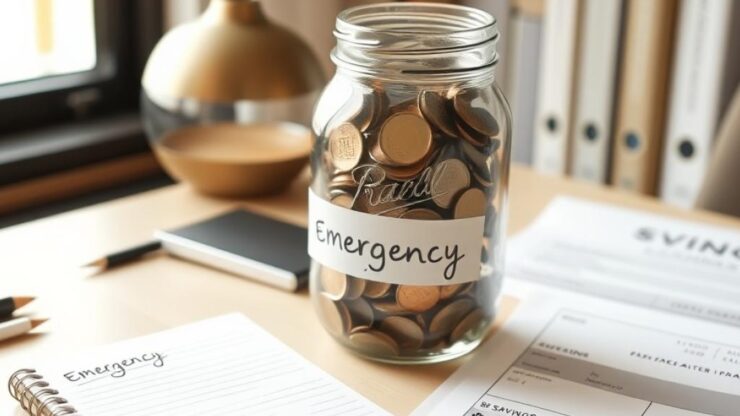Establishing Clear Financial Goals

Establishing a solid financial foundation begins with a clear vision of what you want to achieve. This vision acts as a guiding star, steering your decisions and helping you prioritize your spending. Consider what your long-term financial goals are, such as buying a home, funding your children’s education, or securing a comfortable retirement. When you have these goals in mind, it becomes easier to distinguish between necessary expenses and impulsive purchases.
To ensure that your financial goals are achievable, consider employing the SMART criteria: Specific, Measurable, Achievable, Relevant, and Time-bound. By adhering to this framework, you can create goals that not only motivate you but also provide a clear roadmap for your financial journey.
- Specific: Clearly define what you want to achieve.
- Measurable: Establish criteria for tracking progress.
- Achievable: Set realistic goals within your reach.
- Relevant: Ensure your goals align with your overall financial vision.
- Time-bound: Set deadlines to foster commitment.
Once your goals are established, the next step is to create a detailed financial action plan. This plan should outline the steps you need to take to achieve your goals, including budgeting, saving, and investing strategies. By mapping out your financial journey, you can make informed decisions that keep your emergency fund intact and protect it from impulse spending.
In summary, establishing clear financial goals is essential in safeguarding your emergency fund. By defining your vision, employing the SMART criteria, and creating a comprehensive financial action plan, you can set boundaries that protect your savings while still allowing for meaningful spending aligned with your aspirations.
Creating a Separate Savings Account
One of the most effective strategies to shield your emergency fund from the perils of impulse spending is to create a separate savings account specifically designated for emergencies. This not only adds a layer of protection but also fosters a disciplined approach to managing your finances. By isolating your emergency savings from your daily spending accounts, you can cultivate a mindset that prioritizes saving and reduces the temptation to dip into these funds for non-essential expenditures.
Establishing a distinct account for your emergency fund serves multiple purposes. Firstly, it diminishes the likelihood of accidental spending, as the funds are not readily accessible for day-to-day transactions. Secondly, it helps you track your progress more effectively, providing a clear view of how much you have accumulated for unforeseen situations. Additionally, many financial institutions offer higher interest rates on savings accounts, allowing your emergency fund to grow more effectively.
When selecting a savings account for your emergency fund, there are various factors to weigh to ensure it meets your needs. Below is a list of key considerations to guide your decision-making process:
- Interest Rates: Look for accounts that offer competitive interest rates to maximize growth.
- Accessibility: Ensure the account allows easy access in case of emergencies, but not so easy that you might be tempted to use it for other purposes.
- Fees: Choose accounts with minimal or no fees to prevent unnecessary charges that could diminish your savings.
- FDIC Insurance: Verify that the account is insured, providing an added layer of security for your funds.
Setting up a separate savings account for your emergency fund is a straightforward process. Here are practical steps to help you get started:
- Research various banks and credit unions to find the best savings account that meets your criteria.
- Open the account and set an initial deposit, ideally from your current savings or budget surplus.
- Automate transfers from your checking account to your emergency fund account, reinforcing the habit of saving.
- Regularly review your account to monitor growth and adjust your contributions as necessary.
Implementing a Spending Freeze Policy
In the quest to safeguard your emergency fund from the clutches of impulsive spending, one effective strategy that merits consideration is the Spending Freeze Policy. This approach serves as a temporary yet powerful measure to cultivate a more mindful spending habit, ensuring that your financial priorities remain intact. By instituting a spending freeze, you create a structured environment in which every expenditure is carefully assessed, allowing your emergency savings to flourish.
At its core, a spending freeze involves a predetermined period during which you refrain from non-essential purchases. This can range from a week to several months, depending on your financial goals and circumstances. The key to success lies in establishing clear guidelines that delineate what constitutes essential versus non-essential spending. For instance, while groceries and utilities fall into the essential category, dining out or purchasing new clothing may not. By clearly defining these categories, you can effectively curb discretionary spending and protect your emergency fund.
The implementation of a spending freeze offers numerous advantages that extend beyond merely protecting your emergency fund. First and foremost, it fosters a heightened awareness of your spending habits. As you consciously evaluate each potential purchase, you may discover patterns that reveal unnecessary expenditures you were previously unaware of. This newfound awareness can lead to lasting changes in your financial behaviors, promoting a more disciplined approach to budgeting.
Additionally, a spending freeze can pave the way for significant savings in a relatively short timeframe. By redirecting the funds that would have otherwise been spent on non-essentials into your emergency fund, you can achieve your financial objectives more rapidly. This accumulation of savings not only fortifies your financial safety net but also instills a sense of accomplishment and motivation to continue practicing disciplined spending habits.
While the concept of a spending freeze may seem straightforward, maintaining it can prove challenging. To enhance your chances of success, consider implementing a few strategic measures. First, create a visual reminder of your financial goals—whether it’s a vision board or a simple note in a visible location. This can reinforce your commitment to the freeze and remind you of the bigger picture.
Moreover, enlist the support of friends or family who can serve as accountability partners. Sharing your goals with others can provide encouragement and deter you from straying off course. Lastly, be sure to celebrate your achievements, no matter how small. Recognizing your progress can help sustain your motivation and solidify positive spending habits for the long term.
| Spending Freeze Duration | Potential Savings | Impact on Emergency Fund |
|---|---|---|
| 1 Month | $300 | Increased security for unforeseen expenses |
| 3 Months | $900 | Significant boost to emergency savings |
| 6 Months | $1,800 | Strong financial cushion |
Utilizing Budgeting Tools and Apps
In the journey to safeguard your emergency fund from the temptations of impulsive spending, leveraging budgeting tools and apps can serve as a game-changer. These digital resources empower you to take control of your finances by providing a structured approach to spending, saving, and tracking your financial goals. With the right tools at your disposal, you can create a vigilant system that not only monitors your expenditure but also fortifies your commitment to your emergency savings.
When it comes to selecting budgeting tools, it’s essential to consider your personal financial habits and preferences. Numerous apps offer varied features designed to cater to different users. Some applications, like Mint, provide an all-in-one platform for tracking expenses, creating budgets, and monitoring financial goals in real time. Others, such as YNAB (You Need A Budget), focus on proactive budgeting techniques that encourage users to allocate every dollar towards specific categories, reinforcing the importance of intentional spending. To make an informed decision, compare the functionalities of several tools, focusing on usability, customization options, and integration with your bank accounts.
Once you have identified the budgeting tools that resonate with your financial management style, the next step is to integrate them seamlessly into your daily routine. Start by setting aside specific times each week to review your spending and assess your progress towards your financial goals. This habitual practice not only enhances your awareness of where your money is going but also highlights areas where you may be veering into impulse spending territory. Moreover, many apps offer alert features that notify you when you approach your budget limits, allowing you to make informed decisions before reaching for your emergency fund.
Additionally, consider utilizing the reporting features that many apps provide. These insights can reveal patterns in your spending habits, helping you to identify triggers that lead to impulsive purchases. By understanding these patterns, you can proactively set boundaries that protect your emergency fund while still allowing for necessary expenditures. Ultimately, the effective use of budgeting tools is not just about tracking numbers; it is about fostering a mindset that prioritizes your financial health and aligns with your established goals.
Educating Yourself on Impulse Triggers
In the pursuit of financial stability, understanding the psychological triggers that lead to impulse spending is crucial. By educating yourself on these triggers, you can take proactive measures to safeguard your emergency fund. Recognizing the circumstances and emotions that prompt you to spend can significantly reduce the likelihood of falling into the trap of impulsive purchases. This awareness not only helps in maintaining your financial discipline but also fosters a deeper connection with your spending habits, enabling you to make more informed decisions.
Impulse spending often arises from a variety of emotional states or situational influences. Common emotions such as stress, boredom, or even excitement can lead to unforeseen expenditures. For instance, when faced with a challenging day at work, many individuals might seek solace in retail therapy, leading to unnecessary purchases that can harm their financial health. By identifying these emotional triggers, you can implement alternative coping mechanisms that do not involve spending, such as engaging in physical activities, practicing mindfulness, or pursuing hobbies that bring you joy.
Additionally, situational triggers play a significant role in impulse spending. Environments that encourage spending, such as online shopping platforms with limited-time offers or social gatherings where friends are indulging in shopping sprees, can create an atmosphere conducive to impulsive decisions. By recognizing these situations, you can develop strategies to either avoid them or prepare yourself mentally to resist the temptation to spend. For example, if you know you are prone to impulse buys during social outings, setting a strict budget beforehand can help keep your emergency fund intact.
Once you have identified your specific impulse triggers, the next step is to create tailored strategies to combat them. One effective approach is to establish a personal spending threshold. This involves setting a specific amount of money that you are willing to spend on non-essential items each month. By doing so, you can indulge in occasional purchases without jeopardizing your emergency fund. However, it is vital to adhere strictly to this limit and reassess it regularly to ensure it aligns with your financial goals.
Moreover, incorporating a ‘cooling-off’ period before making significant purchases can also be beneficial. This practice involves waiting for a designated time—be it 24 hours or even a week—before finalizing any non-essential purchase. This pause allows you to reflect on whether the item is truly necessary, ultimately protecting your emergency savings from impulsive decisions.
Furthermore, surrounding yourself with a supportive community can reinforce your commitment to curbing impulse spending. Engaging in conversations with friends or family about your financial goals can provide external accountability, making it more difficult to stray from your budgetary boundaries. By combining self-awareness with supportive social structures, you can create a robust defense against the challenges of impulse spending, ensuring that your emergency fund remains intact and ready for genuine emergencies.
Disclaimer
This article has been created or edited with the support of artificial intelligence and is for informational purposes only. The information provided should not be considered investment advice. Please seek the support of a professional advisor before making any investment decisions.






